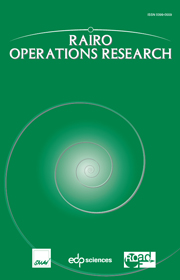Article contents
Computing and proving with pivots
Published online by Cambridge University Press: 09 October 2013
Abstract
A simple idea used in many combinatorial algorithms is the idea ofpivoting. Originally, it comes from the method proposed by Gauss in the19th century for solving systems of linear equations. This method had been extended in1947 by Dantzig for the famous simplex algorithm used for solving linear programs. Fromsince, a pivoting algorithm is a method exploring subsets of a ground set and going fromone subset σ to a new one σ′ by deleting anelement inside σ and adding an element outside σ:σ′ = σ\ { v} ∪ {u},with v ∈ σ and u ∉ σ.This simple principle combined with other ideas appears to be quite powerful for manyproblems. This present paper is a survey on algorithms in operations research and discretemathematics using pivots. We give also examples where this principle allows not only tocompute but also to prove some theorems in a constructive way. A formalisation isdescribed, mainly based on ideas by Michael J. Todd.
- Type
- Research Article
- Information
- Copyright
- © EDP Sciences, ROADEF, SMAI, 2013
References
- 2
- Cited by


